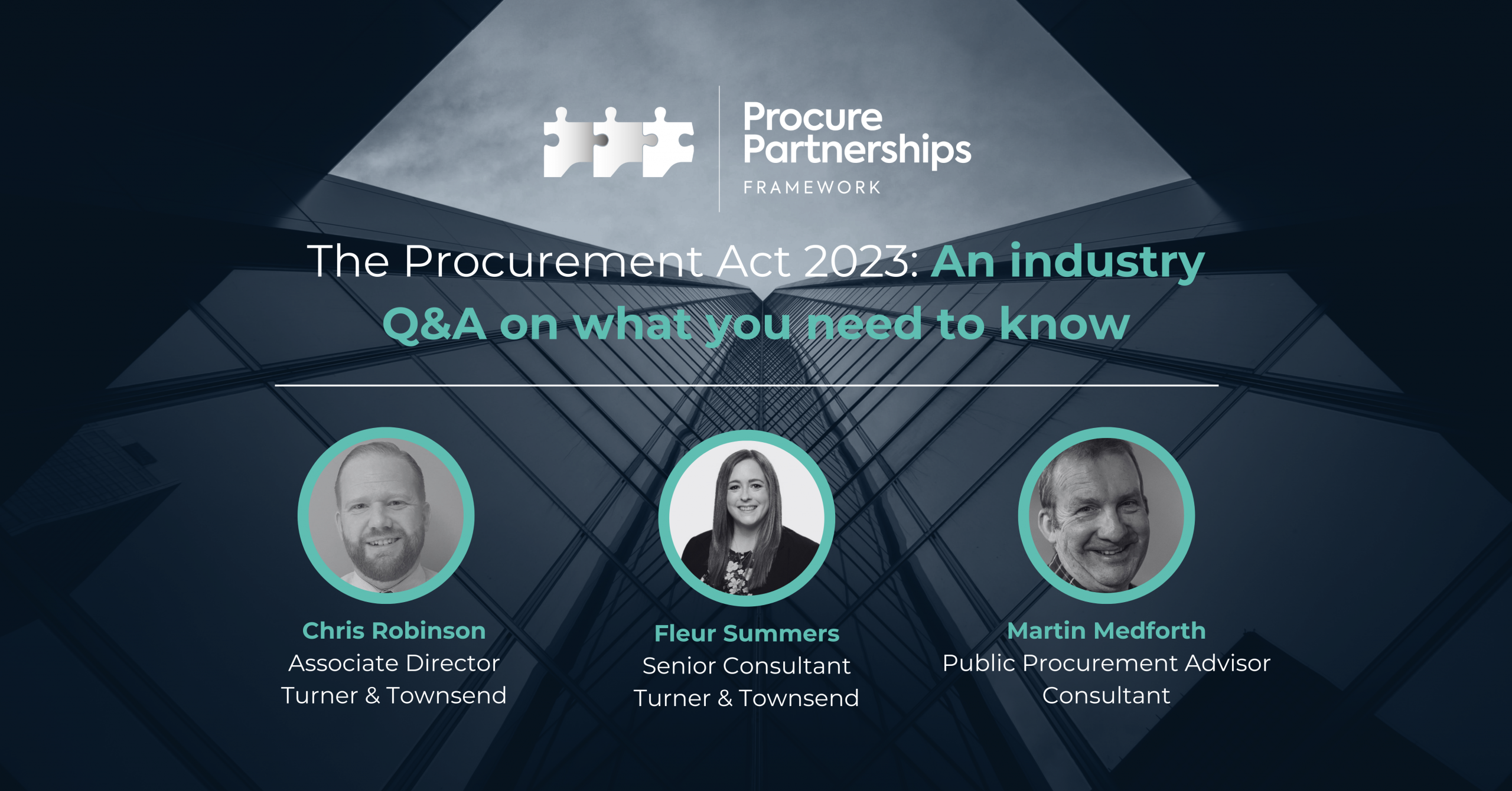With the new Procurement Act 2023 set to overhaul the UK’s public procurement landscape, we caught up with three industry insiders to get their take on the new Act, what it means for procurement, and crucially, what you need to know before the Act comes into force. Chris Robinson, Associate Director at Turner & Townsend, Fleur Summers, Senior Consultant at Turner & Townsend and Public Procurement Advisor, Martin Medforth, shared their insights on the key changes and what both buyers and suppliers should prepare for as the new Act approaches.
So, why do we need a new Procurement Act?
Chris kicks things off by pointing out that the Procurement Act 2023 has been a long time coming, especially for those working in or supporting the public sector. The UK’s exit from the EU provided a golden opportunity to shake up traditional procurement rules. The main aim? Greater flexibility and the ability to embrace more modern, innovative approaches.
The Act consolidates several existing regulations (e.g. Public Contracts Regulations, Utilities Contracts Regulations, Concessions Regulations) into one streamlined set of rules. Fleur adds, “the target behind this is to reduce the amount of duplication and overlap we currently have from having separate regulations and combine them into one set that is uniform and utilised across the sector.” Martin echoes this and adds that the focus has shifted from EU-driven principles to UK-centric objectives. “It’s all about value for money, maximising public benefit, and ramping up transparency,” he says. While the need to treat suppliers fairly remains, there’s now a stronger push to support SMEs and remove barriers they might face.
How does the UK Procurement Act 2023 differ from the old EU rules?
According to Chris, the big difference is that the new Act is now UK-centric, stating “there will be no more links to previous EU derived public contract regulations.” While some familiar processes remain, the Act introduces new approaches that bring more flexibility into the mix.
Martin jumps in to highlight the introduction of fewer structured procurement types. “The biggest change for buyers is probably the Competitive Flexible Procedure,” he explains. This new approach allows procurement processes to be designed on a case-by-case basis. But with this flexibility comes a new challenge—suppliers will need to stay sharp and ensure they fully understand the specifics of each procurement.
What does this mean for how procurements are carried out?
Chris assures us that, overall, things won’t look drastically different—but there are some key changes to be aware of. For starters, transparency is a key theme under the new Act. We will see an increase of the number of notices that will need to be published by public sector procurement professionals, making the process more open and visible. Fleur adds, “this will mean that there is a lot more information available in terms of the stages of the procurement process but also through to the management of the contract.” The industry may also notice different processes being followed, this is due to the introduction of the Competitive Flexible Procedure, giving authorities more room to tailor their procurement processes.
Martin adds that these changes mean there will be more formality and notification requirements throughout the procurement journey. “Buyers will need to be crystal clear about how they plan to run each procurement,” he says. He also points out that for larger contracts, the new Act brings in mandatory KPI reporting to monitor supplier performance—so suppliers should be ready to step up, and equally buyers should start thinking about how they will monitor supply chain performance and KPIs.
Will buyers still be able to use frameworks?
The short answer from Chris is yes, “the use of Framework Agreements will still be available once the new Procurement Act goes live and if there are existing frameworks in place that continue past the implementation date, they will remain based upon the existing rules.” To put it simply, frameworks aren’t going anywhere, but there are some new opportunities. The Act introduces Open Framework Agreements, allowing frameworks to be reopened at set intervals. This is a game-changer because it means suppliers won’t be locked out for long periods if they miss out initially.
Martin is enthusiastic about this development, too. He believes these changes will make frameworks and dynamic markets more flexible and accessible, particularly for SMEs. “Expect procurement bodies to really leverage these new options,” he says, predicting that frameworks will become more dynamic tools for public sector buyers.
How will the Act address concerns about transparency and corruption post-Covid?
Transparency is clearly a central theme in the new Act, as Chris, Fleur and Martin emphasise. Fleur points out that with the increase in required notices—from the start of the procurement process through to contract management—there will be a lot more information readily available to the public and suppliers. Chris expands, “public sector authorities that have a total procurement expenditure of over £100m, will be required to publish a Pipeline Notice of procurements that are anticipated to be required over the next 18 months.” This transparency should support resource allocation for suppliers as they can clearly identify what procurement opportunities are on the horizon.
It doesn’t stop there, during the procurement process, there will be additional notices required around the award of the contract, specifically the new Contract Details Notice, which has to be published once a contract is entered into.
Fleur adds, “Moving onto the contract management side; there will be a requirement for contracts that are equal to or above £5m in value, to publish (on an annual basis) the performance of the contract, and whether assessments conclude supplier performance during that review period is positive or negative.”
Martin agrees and adds that these measures are especially relevant given the scrutiny of public procurement during the Covid-19 pandemic. “The enhanced notification requirements should reassure everyone that public procurement is being conducted with integrity,” he says. He also mentions the new Debarment List, which allows public sector bodies to exclude or debar suppliers from undertaking public contracts.
What should buyers focus on before the Act goes live?
Chris, Fleur and Martin all agree that there’s a lot to do before the new Act kicks in. Chris and Fleur list some key areas to focus on, including getting ready for go-live, updating procurement policy and procedure documents, reviewing digital platforms, and ensuring procurement teams are well-trained. It’s also crucial to engage with stakeholders across the organisation to ensure everyone is on the same page.
Martin adds that systems need to be up to date, especially regarding the publication of notices. Buyers should also start thinking about how they’ll publish pipeline data and adapt to the new requirements.
How will the transition to the new regime be managed?
Chris explains that the transition depends on the timing of procurement notices. “The date of when Contract Notices are published is going to be key here. For example, if a Contract Notice to commence a procurement is prior to the go live date (28th October 2024), then the procurement and the subsequent contract, even if it is for 10 years, will be based upon the existing regulations.
Alternatively, if a Contract Notice, or Tender Notice as it will be known, is published after the 28th October 2024, this will mean that the procurement and the awarded contract will be based upon the new Procurement Act regulations.”
Martin warns suppliers to be prepared for the increased governance and transparency that will come with the new Act. “Even though existing contracts won’t be affected, it’s essential to start planning for the new rules now,” he advises.
So, what does this mean for suppliers?
The new Act will bring several changes for suppliers, and Fleur and Martin outline the key areas to watch out for. Transparency is at the top of the list, with more information being made publicly available. Social value is also gaining greater importance, with a shift from “Most Economically Advantageous Tender”, to “Most Advantageous Tender.”
Fleur advises that for contracts already in place, there will be no impact to them and the regulations that govern them, stating, “the only change that will come is if they are re-procured and the procurement commences after the 28th October 2024, as it will therefore mean that any new procurement will be based on the new regulations.”
Suppliers will need to adapt to the new procedures, such as the Competitive Flexible Procedure and Open Frameworks. Martin also highlights the introduction of a new Central Digital Platform for publishing procurement opportunities, which suppliers should keep an eye on. “Performance reporting will also play a bigger role, and that could influence future bid opportunities,” he says.
Final thoughts
While the new Procurement Act 2023 introduces some significant changes, Chris, Fleur and Martin all agree that the core principles of public procurement—openness, fairness, and equality—remain unchanged. The key to navigating the transition successfully is preparation and a clear understanding of the new procedures. As Martin puts it, “It’s all about being ready for what’s coming and making the most of the new opportunities.”
How we can support
Procure Partnerships Framework are geared to support public sector organisations in meeting the requirements of the Procurement Act 2023. The framework already monitors supply chain performance and project KPIs through the digital platform, Compliance Chain, so you don’t have to.
At Procure Partnerships Framework, you can expect a driven, dedicated team of procurement and project delivery specialists who will support you in navigating the new Act. If you have any questions on how the new regulations may impact your project, get in touch with your regional key account manager today.



